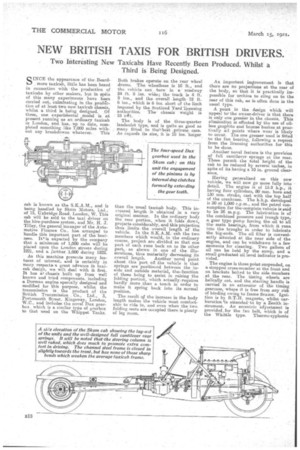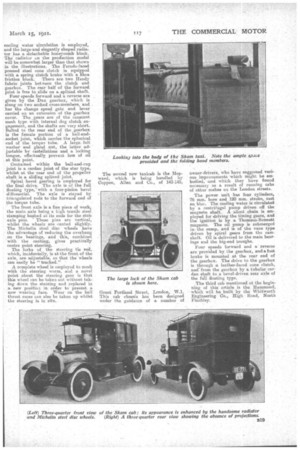NEW BRITISH TAXIS FOR BRITISH DRIVERS.
Page 22

Page 23

If you've noticed an error in this article please click here to report it so we can fix it.
Two Intersting New Taxicabs Have Recently Been Produced. Whilst a Third is Being Designed.
Q INCE the appearance of the Beard10 more taxicab, little has been heard in connection with the production of taxicabs by other makers, but in spite of this many experiments have been carried out, culminating in the procliktion of at least two new, taxicab chaseis, whilst a third is being designed. Of these, one experiniental _model is at present running as an ordinary taxicab in London, and has, up to date, completed something like 7.000 miles with
out any breakdowns whatever. This cab is known as the S.K.A.M., and is being handled by Skam Motors, Ltd., of 15, Uxbridge Road. London, W. This cab will be sold to the taxi driver on the hire-purchase system, and Mr. H. J. Tilley, the general manager of the Automotive Finance Co., has arranged to handle this important part of the business. It'is expected by the company that a minimum of 1,000 cabs will be placed upon the London streets during 1921, and a inrther .1,000 during 1922.
• As this machine presents many features of interest, end is certainly in many respects. a great. advance in taxicab design, we wilt deal with it first. It has *0 chassis built up from well known and tried components. including a Dorman engine specially designed and modified for this purpose, whilst the transmission is the product of the British Transmission Co., Ltd. 3, Portsmouth Street, Kingsway, London, W.C., and includes the novel Dux gearbox, which is a similar type of gearbox to that used on the Whippet Tanks.
Both brakes operate on the rear wheel drums. The wheelbase is 10 ft., and thii vehicle can turn in a roadway 24 ft. 8 ins, wide; the track is 4 ft. 9 ins., and the overall length12 ft. 6 ins., which is 6 ins, short of the limit imposed by the Scotland Yard lic,ensing authorities. The chassis Weight is 18 cat.
The body is of the three-quarter landaulet type, and is suite as goad as many fitted to thewbest ,privatecars. As regards its size, it is 18 ins. longer
than the usual taxicab body. This increased length is obtainedin a very original manner. In the ordinary body the rear portion, when it folds down, projects considerably, and -this projection thus. limits, the overall length of the vehicle. In the S.K.A.M, cab the two members which would,in the ordinary course, project are divided so that one part of each runs back on to its other part, as shown in one of the illustrations, thus materially decreasing its overall length. Anrither -novel point about this part a the vehicle is that springs are positioned between the inside and outside material, the. function of these being to assist in raising the folding portion; which actually.,requires hardly more than a touch in order to make it spring back into its normal position.
The result el the increase in the body length makes the vehicle most comfortable to ride in, and even when the two folding seats are occupied there is plenty of leg room. An important improvement is that there are no projections at the rear of the body, so that it is practically impossible for urchins to cling on to the rear of this cab, as is. often done in the usual type.
A point in the design which will appeal to. the owner-driver is that there is only one greaSer in the chassis. This elimination is effected by the use of oilless graphite and bronze bushes at practically all points where wear is likely to occur. Time one greaser used is fitted to the fan bearing, following a request from the licensing authorities for this to be done.
Another novel feature is the provision of full cantilever springs at the rear. These permit the total height of the cab to be reduced by several inches, in spite of its having a 10 in. ground clearance.
Hiving generalized on this new vehicle, we will now go more fully into detail. The engine is of 15.9 h.p., it having four cylinders, 80 mm, bore and 130 min, stroke, cast. with the top half of the crankcase. The b.h.p. developed is 20 at 1,000 r.p.m., and-the petrol consumption for the-complete vehicle is said to be 26 m.p.g. The lubrication is of' the combined pressure and trough type, a gear type pump forcing the oil to all the main bearings, from which it runs into the troughs in order to lubricate the big-ends. The oil filter is conveniently situated at the near side of the engine, and can be withdrawn in a few moments for cleaning. Two gallons of oil can be held by the sump, and a small graduated oil level indicator is provided.
The engine is three-point suspended, on a dropped cross:member at the front and on brackets bolted to the side members at the rear. The timing wheels are helically cut. and the starting handle is carried in an extensior of the timing gearcase, where it is free from any risk of binding owing to frame flexion. Ignition is by B.T.H. magneto, whilst carburation is attended-to by a Zenith instrument. Au eccentric adjustment is provided, for the fan belt, which is of the Whittle type. Thermo-syphonie
cooling water circulation is employed, and the large•and elegantly shaped radiator has a .detachable honeycomb block. The radiator cal the production model will be somewhat larger than that shown in the illustrations. The Ferodo-faced pressed steel cone clutch is equipped with a. spring clutch brake with a fibre friction block. There are two Hardy fabric joints between the clutch and gearbox, The rear half of the forward joint is free to slide on a•eplined shaft. 'Four speeds forward and a reverse are given by the Dux gearbox, which is slung on two arched cross-members, and has the change epeed gate and lever carried on an extension of the gearbox cover. The _gears are of the constant mesh type with internal dog clutch engagement, and the shafts are very short. Bolted to the rear end of the gearbox is the female portion of a ball-andsocket joint, which carries the spherical end of the torque tube. A large. felt washer and gland nut, the latter adjustable by castellations and a locking tongue, effectually prevent loss of oil at this point.
Contained within the ball-and-cup joint is a earclan joint of the star type, whilst at the •rear end of the propeller shaft is a sliding splined joint. Spiral. bevel gearing is employed for the final drive. The axle is of the full floating type,' with a four-pinion bevel differential. The axle is stayed by triangulated rods to the forwand end of the torque tube.
The front axle is a fine piece of work, the main, axle being a high tensile steel stamping bushed at its ends for the stub
axle pins. These pins are vertical, whilst the wheels are -canted slightly. The Michelin steel disc wheels have the advantage of reducing the overhang on the bearings, and this, combined with the canting, gives practically centre point steering. •
The forks of the steering tie rod, which, incidentally, is at the front of the axle, are adjustable, so that the 'wheels can easily be "tracked."
A complete wheel is employed to mesh with the steering worm, and a novel point about the steering gear is that this wheel can be taken out without talcmg down the steering and replaced in a • new positioa in order to present a new wearing face. Wear on the ball thrust races can also he taken up whilst the steering is in situ. The second new taxicab is the Mepward, which is being handled by Coppen, Allen and Co., of 143-145, Great Portland Street, This cab chassis has under the guidance of London W.1. been designed a number of owner-drivers, who have suggested various improvements which might be embodied, -and which they have found necessary as a result of running cabs of other makes on the London streets.
The power unit; has four cylinders, mm. bore and 120 mm. stroke, cast en bloc. The cooling water is circulated by a centrifugal pump driven off the magneto shaft. A silent ehain is employed for driving the timing gears, and the ignition is by a. Thomson-Bennett magneto. The oil pump is submerged inthe sump, and is of the vane type driven by spiral gears from the camshaft. Oil is delivered to the main bearings and the big-end troughs.
Four speeds forward and a reverse are provided by the gearbox, ancla foot brake is mounted at the rear end of the gearbox, The drive to the gearbox is through a leather-faced cone clutch, and from the gearbox by a tubular =den shaft to a bevel-driven Tear axle of the full floating type.
The third cab mentioned at the beginning of this article is the Hammond, • which will be built by the Whitworth Engineering Co., High Road, North Finchley.
































